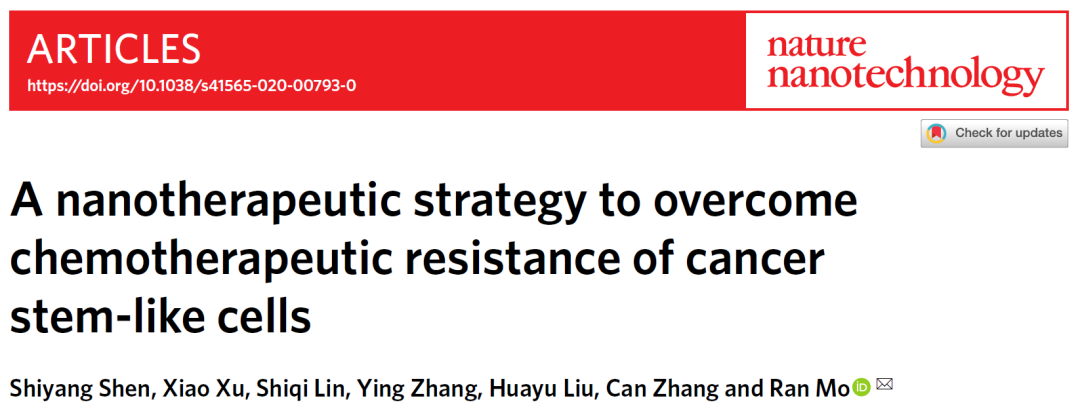New nanocarriers to overcome tumor heterogeneity and reduce drug resistance
- A Single US$2.15-Million Injection to Block 90% of Cancer Cell Formation
- WIV: Prevention of New Disease X and Investigation of the Origin of COVID-19
- Why Botulinum Toxin Reigns as One of the Deadliest Poisons?
- FDA Approves Pfizer’s One-Time Gene Therapy for Hemophilia B: $3.5 Million per Dose
- Aspirin: Study Finds Greater Benefits for These Colorectal Cancer Patients
- Cancer Can Occur Without Genetic Mutations?
New nanocarriers to overcome tumor heterogeneity and reduce drug resistance
New nanocarriers to overcome tumor heterogeneity and reduce drug resistance. Nature Sub-Journal: Cancer Nemesis! The Mo Ran team of China Pharmaceutical University develops new nanocarriers to overcome tumor heterogeneity and reduce drug resistance.

The rise and rapid development of nanotechnology has brought a new dawn for humans to cure cancer, and it has become one of the most popular research directions in the field of tumor treatment today. Of course, the existing nano-therapeutic methods for tumors still have certain shortcomings, and many scientific researchers are constantly developing new and more efficient therapies.
On January 12, 2021, the Mo Ran team of the State Key Laboratory of Active Components and Pharmacodynamics of Natural Medicines of China Pharmaceutical University published a titled: A nanotherapeutic strategy to overcome chemotherapeutic resistance of cancer stem-like cells in Nature Nanotechnology. Research papers on nano-therapeutic strategies for stem cell-like cell chemotherapy resistance
This study reports a novel nano-therapeutic strategy-using nanoparticles to co-carry differentiation inducer all-trans retinoic acid (ATRA) and chemotherapy drug camptothecin (CPT)-ATRA/CPT-NPs, to kill Cancer stem cells (CSCs) in tumors. This dual strategy enables the controlled release of drugs in cancer stem cells (CSCs), reduces stem cell-related drug resistance, and enhances chemotherapy response.

Tumor heterogeneity is a major obstacle to cancer treatment. Tumor tissue contains a variety of different cells, which have different phenotypic characteristics and different sensitivities to treatment. It is worth noting that cancer stem cells (CSCs) are considered to be one of the determinants of tumor heterogeneity.
Cancer stem cells have the characteristics of self-renewal, high tumorigenicity, invasiveness and resistance to traditional chemotherapy and radiotherapy. Many studies have shown that the existence of cancer stem cells (CSCs) is the culprit in the progression, recurrence and metastasis of multiple malignant tumors . From this point of view, in order to completely cure tumors, the first thing to do is to solve the problem of tumor stem cells.
In this study, the research team of China Pharmaceutical University proposed a combination therapy strategy that uses nanomedicine controlled by cell differentiation to overcome the obstacles of tumor stem cell (CSCs)-derived tumor heterogeneity treatment: all-trans retinoic acid ( ATRA) and the chemotherapy drug camptothecin (CPT) are co-loaded on a nanocarrier. Previous studies have confirmed that these two drugs have a synergistic effect on tumor killing.

ATRA/CPT-NPs are composed of n-HA-oxa-CPT and are physically wrapped by ATRA
Ingeniously, in order to customize the drug release behavior on demand, the research team designed a system that can change with the differentiation state of cancer stem cells (CSCs) based on the different physiological characteristics of cancer stem cells (CSCs) in the undifferentiated and differentiated state. Nanoparticles that change their drug release behavior-ATRA/CPT-NPs.
When cancer stem cells (CSCs) are in an undifferentiated state, all-trans retinoic acid (ATRA) is released under this hypoxic condition and induces cancer stem cells (CSCs) to differentiate into non-cancer stem cell lines, thereby continuously reducing the number of cells in tumor tissues Dryness and chemotherapy resistance. Not only that, with the differentiation of cancer stem cells (CSCs), the increase of mitochondria leads to an increase in the level of reactive oxygen species, which in turn regulates the release of camptothecin (CPT) from ATRA/CPT-NPs and kills tumor cells.

ATRA/CPT-NPs can adaptively adjust the drug release ratio for different cell types
Simply put, ATRA/CPT-NPs can adaptively adjust the drug release ratio for different cell phenotypes (including CSCs and non-CSCs). In addition, ATRA and CPT in nanoparticles have a synergistic effect-ATRA can enhance the sensitivity of cancer stem cells (CSCs) to CPT and prevent the upregulation of cell stemness induced by CPT stress, thereby maximizing the elimination of tumors in tumor tissues Stem cells (CSCs).
The synergistic effect of ATRA and CPT on reducing the dryness of CSCs, alleviating tumor hypoxia, and inhibiting tumor cell proliferation
More convincingly, the research team also found that ATRA/CPT-NPs can effectively inhibit the growth, recurrence and metastasis of heterogeneous breast tumors rich in cancer stem cells (CSCs) in mouse models, confirming ATRA/CPT-NPs Has a very bright therapeutic application prospect!
In this regard, the author wrote in the paper: “Our research findings provide a promising perspective for exploring fusion nano-therapeutics to overcome cancer stem cell (CSCs)-related chemotherapy resistance!”

In mouse models, ATRA/CPT-NPs inhibit the growth, recurrence and metastasis of primary tumors
All in all, this study designed an ingenious and efficient nanoparticle—ATRA/CPT-NPs, which can adjust the release ratio of the two drugs according to the differentiation state of cancer stem cells (CSCs) in tumor tissues, and kill tumors. At the same time, it can also avoid tumor heterogeneity and drug resistance caused by cancer stem cells (CSCs), which reveals a new direction for tumor treatment!
(source:internet, reference only)
Disclaimer of medicaltrend.org



